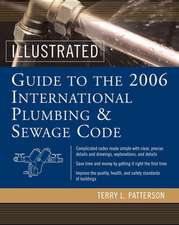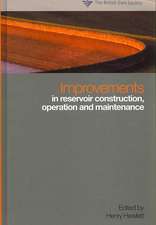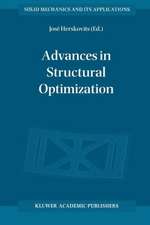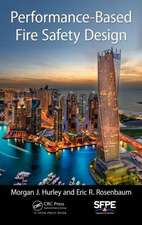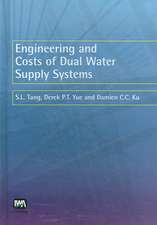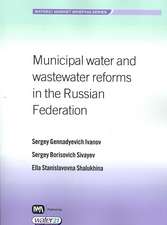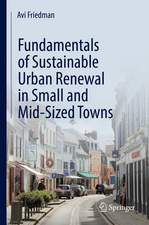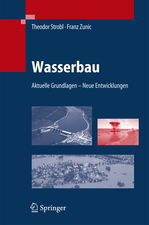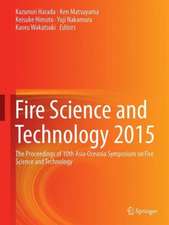SFPE Handbook of Fire Protection Engineering
Editat de Morgan J. Hurley, Daniel T. Gottuk, John R. Hall Jr., Kazunori Harada, Erica D. Kuligowski, Milosh Puchovsky, Jose´ L. Torero, John M. Watts Jr., CHRISTOPHER J. WIECZOREKen Limba Engleză Hardback – 7 oct 2015
With seventeen new chapters and over 1,800 figures, the this new edition contains:
- Step-by-step equations that explain engineering calculations
- Comprehensive revision of the coverage of human behavior in fire, including several new chapters on egress system design, occupant evacuation scenarios, combustion toxicity and data for human behavior analysis
- Revised fundamental chapters for a stronger sense of context
- Added chapters on fire protection system selection and design, including selection of fire safety systems, system activation and controls and CO2 extinguishing systems
- Recent advances in fire resistance design
- Addition of new chapters on industrial fire protection, including vapor clouds, effects of thermal radiation on people, BLEVEs, dust explosions and gas and vapor explosions
- New chapters on fire load density, curtain walls, wildland fires and vehicle tunnels
- Essential reference appendices on conversion factors, thermophysical property data, fuel properties and combustion data, configuration factors and piping properties
Preț: 5657.38 lei
Preț vechi: 7071.73 lei
-20% Nou
Puncte Express: 8486
Preț estimativ în valută:
1082.51€ • 1130.24$ • 895.94£
1082.51€ • 1130.24$ • 895.94£
Carte disponibilă
Livrare economică 14-28 martie
Livrare express 27 februarie-05 martie pentru 277.19 lei
Preluare comenzi: 021 569.72.76
Specificații
ISBN-13: 9781493925643
ISBN-10: 1493925644
Pagini: 3493
Ilustrații: LIII, 3493 p. 1626 illus. In 3 volumes, not available separately.
Dimensiuni: 178 x 254 x 157 mm
Greutate: 7.48 kg
Ediția:5th ed. 2016
Editura: Springer
Colecția Springer
Locul publicării:New York, NY, United States
ISBN-10: 1493925644
Pagini: 3493
Ilustrații: LIII, 3493 p. 1626 illus. In 3 volumes, not available separately.
Dimensiuni: 178 x 254 x 157 mm
Greutate: 7.48 kg
Ediția:5th ed. 2016
Editura: Springer
Colecția Springer
Locul publicării:New York, NY, United States
Public țintă
Professional/practitionerCuprins
Introduction to Fluid Mechanics.- Conduction of Heat in Solids.- Convection Heat Transfer.- Radiation Heat Transfer.- Thermochemistry.- Chemical Equilibrium.- Thermal Decomposition of Polymeric Materials.- Structural Mechanics.- Properties of Building Materials.- Chemical Kinetics and Fire.- Diffusion Flames.- Fundamentals of Premixed Flames.- Fire Plumes, Flame Height, and Air Entrainment.- Ceiling Jet Flows.- Vent Flows.- Effect of Combustion Conditions on Species Production.- Flammability Limits of Premixed and Diffusion Flames.- Ignition of Liquids.- Smoldering Combustion.- Spontaneous Combustion and Self-Heating.- Flaming Ignition of Solid Fuels.- Electrical Fires.- Surface Flame Spread.- Smoke Characterization and Damage Potential.- Heat Fluxes from Fires to Surfaces.- Heat Release Rates.- Calorimetry.- The Cone Calorimeter.- Compartment Fire Modeling.- Estimating Temperatures in Compartment Fires.- Zone Computer Fire Models for Enclosures.- Modeling Fires Using Computational Fluid Dynamics (CFD).- Enclosure Smoke Filling and Fire-Generated Environmental Conditions.- Methods for Predicting Temperatures in Fire Exposed Structures.- Fire Load Density.- Combustion Characteristics of Materials and Generation of Fire Products.- Performance-Based Design.- Fire Scenarios.- Engineering Considerations for Fire Protection System Selection.- Design of Detection Systems.- Hydraulics.- Automatic Sprinkler System Calculations.- Halon Design Calculations.- Clean Agent Total Flooding Fire Extinguishing Systems.- Carbon Dioxide Systems.- Water Mist Fire Suppression Systems.- Foam Agents and AFFF System Design Considerations.- Foam System Calculations- Considerations for Coordinating and Interfacing Fire Protection and Life Safety Systems.- Smoke Control.- Smoke Management by Mechanical Exhaust or Natural Venting.- Structural Fire Engineering of Building Assemblies and Frames.- Analytical Methods for Determining Fire Resistance of Steel Members.- Analytical Methods for Determining Fire Resistance of Concrete Members.- Analytical Methods for Determining Fire Resistance of Timber Members.- Egress Concepts and Design Approaches.- Selecting Scenarios for Deterministic Fire Safety Engineering Analysis – Life Safety for Occupants.- Human Behavior in Fire.- Employing the Hydraulic Model in Assessing Emergency Movement.- Computer Evacuation Models for Buildings.- Visibility and Human Behavior in Fire Smoke.- Combustion Toxicity.- Assessment of Hazards to Occupants from Smoke, Toxic Gases, and Heat.- Engineering Data.- Liquid Fuel Fires.- Fire Hazard Calculations for Large, Open Hydrocarbon Fires.- Vapor Clouds.- Effects of Thermal Radiation to People Predicting 1st and 2nd Degree Skin Burns.- Flammable Gas and Vapor Explosions.- Dust Explosions.- BLEVEs and Fireballs.- Introduction to Fire Risk Analysis.- Probability & Statistics.- Reliability, Availability, and Maintainability.- Building Fire Risk Analysis.- Uncertainty.- Decision Analysis.- Data For Engineering Analysis.- Measuring Fire Consequences in Economic Terms.- Computer Simulation for Fire Risk Analysis.- Engineering Economics.- Fire Risk Indexing.- Risk-Informed Industrial Fire Protection Engineering.- Product Fire Risk Analysis.- Health Care Application of Quantitative Fire Risk Analysis.- The Building Envelope - Fire Spread, Construction Features and Loss Examples.- Wildland fires.- Fires in Vehicle Tunnels.- Fire Risk Assessment for Nuclear Power Plants.- Fire Risk in Mass Transportation.- Appendix A: Conversion Factors.- Appendix B: Thermophysical Property Data.- Appendix C: Fuel Properties and Combustion Data.- Appendix D: Configuration Factors.- Appendix E: Piping Properties.
Recenzii
Notă biografică
About the Editor-in-Chief: Morgan Hurley is a project director for Aon Fire Protection Engineering. He also serves as adjunct faculty at the University of Maryland and California Polytechnic University. He holds bachelors and masters degrees in fire protection engineering, is a licensed professional engineer and he is a Fellow of the Society of Fire Protection Engineers. About the Society: SFPE’s mission is to define, develop and advance the use of engineering best practices; expand the scientific and technical knowledge base; and educate the global fire safety community, in order to reduce fire risk.
Textul de pe ultima copertă
The definitive reference on fire protection engineering, now expanded to three volumes
Available in electronic format for the first time
An indispensible source for reliable coverage of fundamentals, fire dynamics, hazard calculations, fire risk analysis, modeling and more
SFPE members, please contact SFPE for special discount price
Available in electronic format for the first time
An indispensible source for reliable coverage of fundamentals, fire dynamics, hazard calculations, fire risk analysis, modeling and more
SFPE members, please contact SFPE for special discount price
Caracteristici
The definitive reference on fire protection engineering, now expanded to three volumes Available in electronic format for the first time An indispensible source for reliable coverage of fundamentals, fire dynamics, hazard calculations, fire risk analysis, modeling and more SFPE members, please contact SFPE for special discount price

